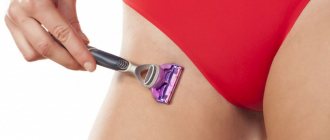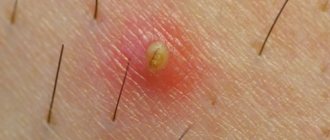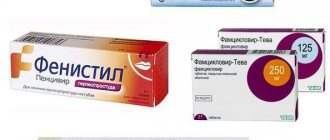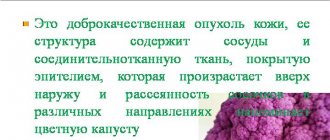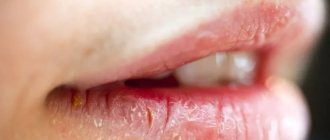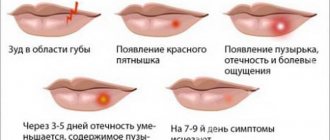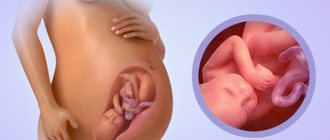Herpes in the groin in men is a fairly common sexually transmitted disease. In men, the risk of contracting a herpes infection is much lower than in women, which is due to physiological characteristics.
You can become infected with the virus even if you have protected sexual intercourse, since condoms cannot provide a 100% guarantee of protection. One touch to the affected area of the partner's skin is enough for a blistering rash to appear in the groin area within a few days. For example, if a woman’s vesicles are localized in the buttocks area, then the infected fluid can enter the man’s groin area during sexual intercourse.
The disease is accompanied by enlargement of the inguinal lymph nodes, which when pressed causes severe pain. Body temperature may rise against the background of a state of general malaise. Therefore, it is important to understand how to treat inguinal herpes, which doctor should be consulted in the event of a primary episode of the disease and if a repeated exacerbation occurs.
More about the pathogen
Male herpes is caused by HSV-2, a member of the herpesvirus family. According to WHO statistics, more than 400 million people of reproductive age are infected with it (about 11% of the world's population).
Note! According to the latest data, HSV-1, which is usually the cause of “colds” on the lips, under certain conditions can also provoke the development of genital herpes.
Herpesvirus type II is neuroinvasive. This means that after infection it migrates to the cells of the nervous system (sacral ganglia) and remains there forever. Currently, no treatment methods have been developed to completely remove this pathogen from the body.
The virion has a round shape. Its diameter is 120-200 nm. The structure of the pathogen provides for the presence of:
- supercapsid (outer shell), consisting mostly of lipoproteins;
- glycoproteins about 10 nm long, which cover the surface of the virus like spikes;
- tegument, or internal protein shell that protects the pathogen from the adverse effects of the external environment;
- a capsid shaped like a twenty-sided capsid that protects the DNA;
- a core containing the nucleotide itself; HSV-2 DNA consists of 20 genes.
The virus maintains good stability in the environment. At a temperature of 50°C it dies after 30 minutes; when frozen it can maintain viability indefinitely.
Kill the pathogen:
- X-rays;
- ultraviolet radiation;
- alcohol;
- organic solvents;
- main disinfectants.
Ways to treat blisters in the groin
Often patients are interested in what to anoint the blisters in the groin to get rid of them. No doctor, if he is competent, will give any recommendations until he has established an accurate diagnosis. For the same reason, they should never self-medicate.
Trying to choose a medicine on your own can only make the situation worse. Depending on the origin of the disease, the following may be recommended:
- stopping contact with allergens and using antihistamines;
- choosing good diapers for children with heat rash, choosing high-quality, breathable clothing that will optimize the evaporation of sweat and prevent the skin from getting too wet;
- antibacterial drugs can be prescribed for both external and internal use in order to cope with a bacterial infection;
- in the fight against viruses, antiviral drugs can be used, which are selected based on the identified pathogen;
- in case of autoimmune reactions, medications based on hormones can be prescribed, with the help of which the body’s excessive aggression against itself will be suppressed;
- fungal diseases will be treated with antimycotic drugs, which, depending on the severity of the disease, can be prescribed both externally and internally.
The treatment regimen for blisters in the groin with drugs depends on what specific disease is identified in a particular patient.
Symptoms of the disease
It is important to consider how the disease develops in the male half of the population:
- At the initial stage, a man may feel discomfort in the groin area. Unpleasant sensations do not necessarily occur within a few days after sexual intercourse. External manifestations of herpes are provoked by the following factors: weakening of the body’s immune forces, colds, chronic fatigue and stress.
- Itching and burning occur in the area of maturation of the inflammatory process. Occasionally, discharge from the urethra is observed. Therefore, men may believe that they have become infected with syphilis, which has similar external symptoms.
- There is an increase in lymph nodes with herpes type 2, which creates additional discomfort for a man. Urination may become painful.
- A blistering rash appears, accompanied by severe itching. Then the bubbles burst, and ulcers appear in their place. After 10 days, a crust forms, which cannot be peeled off on your own to avoid scars.
With proper treatment, no marks remain on the skin, and relapses will be extremely rare. Therefore, it is worth considering an appropriate treatment regimen for this insidious disease.
Pediculosis and groin rashes
Many people tend to mistakenly believe that lice are a relic of the past, a companion to war or homelessness.
However, as medical practice shows, this disease is still common. Moreover, it often occurs even among very prosperous groups of the population. Rashes in the groin due to pubic lice are in most cases small.
Located at a distance from each other, they are distinguished by the fact that they are accompanied by pronounced itching sensations. People become infected with lice pubis if they have sexual contact with a person who himself suffers from the disease.
Moreover, unlike other diseases from the STD group, a condom is not able to protect against lice. Since it does not cover the pubic area.
However, it is still impossible to classify the pubic form of pediculosis in the full sense as a sexually transmitted infection. Some particularly sensitive patients may complain to the doctor that they feel as if someone is crawling on their skin. This is quite unpleasant, but it can immediately give the doctor an idea in which direction to conduct a diagnostic search.
Read also: Rashes on the genitals
How the virus spreads
Genital herpes is a type 2 virus. It is considered a highly contagious disease as it is easily transmitted from person to person. Herpes in men in the groin area has 3 ways of spreading:
- sexual;
- transfusion (with blood transfusion);
- domestic.
The transfusion method of infection is less common than others, since donor blood undergoes a series of laboratory tests. Only when there is a need for emergency blood transfusion from person to person can infection occur.
Red spots in the groin area
The household method is widespread, since the virus can live outside the host for quite a long time. Infection can occur through the use of other people's hygiene items, bed linen, dishes, and clothing. But most often, genital herpes infects the male body during sexual intercourse.
In order for the virus to gain a good foothold in the human body, it must enter the bloodstream. Therefore, the “entry gate” for the virus is the injured mucous membrane. A small microcrack is enough for the pathogen to easily enter the body.
Herpes in the groin is more common in women than in men for physiological reasons. Due to the fact that the urethral opening in representatives of the stronger sex is small, the likelihood of virus penetration is low, even if the pathogen gets on the skin next to the canal. The female body is designed in such a way that during sexual intercourse there is complete contact between the vaginal mucosa and the male penis, so it is almost impossible to avoid infection from an infected partner.
Other non-infectious factors
In addition to allergies, poor choice of underwear and poor hygiene, skin rashes in the groin can be caused by a number of other non-infectious factors that should not be forgotten.
Read also Why pain occurs during sex
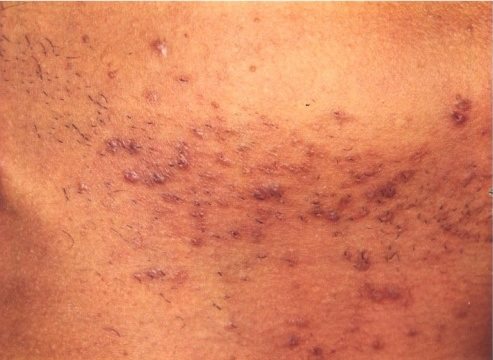
You will have to exclude together with your doctor:
- rashes in the groin after shaving, which can appear in any person if he shaves hair against its growth, ignores other recommendations for proper hair removal
- the appearance of characteristic changes due to ingrown hair, which can also be a consequence of improper shaving of the genital area
- the use of intimate hygiene products that, for one reason or another, are not suitable for the skin of a particular person
- the presence of poorly controlled diabetes mellitus, which can affect the vascular and nerve trunks in the genital area, reducing blood flow and innervation, which contributes to decreased healing and less resistance to infections
- Diaper rash in young children is quite common due to prolonged wearing of diapers, which do not allow the skin to breathe normally, and can also occur in adults who are forced to wear diapers due to problems with urinary incontinence
- some oncological pathologies of the genitals can lead to a rash appearing in the groin area, which will be quite difficult to ignore for a person who cares about their health
It is important, with the help of a doctor, to distinguish non-infectious factors from infectious ones.
Indeed, in the second case, a person poses a significant threat not only to himself, but also to the people who surround him.
Methods for diagnosing the disease
Diagnosis and treatment of genital herpes should be carried out by a specialized specialist. The doctor collects complaints, medical history and prescribes additional tests. In 90% of cases, examination of the affected areas is sufficient to make a diagnosis.
- Tests confirming genital HSV:
- Detection of viral DNA in scrapings of visually healthy areas of skin or mucous membrane.
- Detection of genital HSV DNA or antigens in vesicle contents.
- Detection of IgM antibodies in the blood during acute infection or IgG during chronic infection. For diagnosis, enzyme-linked immunosorbent assay (ELISA) is used.
The last method is the most accurate. ELISA has 99.9% specificity.
Blisters on the head in the hair: causes, symptoms, treatment methods
What to do if you find blisters in your hair?
Anyone can experience such an unpleasant phenomenon as blisters. And, if their appearance on the hands can somehow be explained (allergy to powders, cosmetics), then the appearance of blisters on the head in the hair causes fear and bewilderment.
What could it be and how to get rid of them? Blisters on the scalp can appear for various reasons and can create great difficulties.
Many of them begin to itch, others do not make themselves felt at all, but interfere with caring for your hair, combing it, and washing your hair.
Why do blisters appear on the head in the hair?
There may be several reasons for this occurrence. A visit to a dermatologist and trichologist and passing the appropriate tests will help you understand exactly why they appear . Doctors identify several main reasons for the appearance of blisters.
First of all this:
- allergic dermatitis as a reaction to the wrong selection of shampoo, hair mask or other cosmetic product;
- folliculitis – inflammation of the hair follicle;
- an infectious disease, such as herpes, lichen or chickenpox;
- sebaceous gland cyst;
- acne and blockage of sebaceous glands;
- other reasons indicated by the analysis.
In some situations, blisters occur when the body is damaged by a fungal infection or a sexually transmitted disease. They can also occur if you are allergic to dyes, hats, or hair dyes.
To determine the exact cause of their occurrence, you should consult a doctor, get tested and try to remember why exactly they arose and stop using this product for a while. For example, shampoo, hat or hair mask.
To do this, you will need to come to the store where you bought it, along with the cosmetic product, a receipt, a passport and a dermatologist's report. You will be required to pay the cost of purchase and treatment.
How to treat such blisters
There is no clear answer to this question. It all depends on the cause of the appearance, which only a doctor can identify. If you know exactly why they appeared, you need to stop contacting your hair with some substance.
For example, paint, low-quality shampoo, even a herbal decoction, the composition of which can cause allergies.
Doctors advise combining traditional methods of treatment with medications.
The former can help in case of inflammation caused by external causes, contact with an allergen or a substance that contains an infection.
For example, if you yourself understand that the reason for the appearance of blisters is a reaction to coloring, then you will only need to limit yourself to restorative home or salon procedures.
Most likely, you will need to undergo all the necessary tests to treat the internal cause of the rash. If the cause of the rash is not determined, it is not recommended to use only folk remedies. They will not eliminate the cause of the blisters and may increase the discomfort.
Should I see a doctor about this?
In such a situation, it is simply necessary to consult a doctor, since only accurate tests will help determine the true cause of the rash. It is best to go to a skin and venereal disease clinic for an appointment with a dermatologist or trichologist.
This video will tell you what folliculitis is:
These specialists are also available in some beauty salons. They will take the necessary tests and be able to select treatment.
It is also worth visiting an allergist, taking the necessary allergy tests, a venereologist if there are reasons to contact this specialist, and an endocrinologist if you notice excessive sweating, the appearance of acne on the face, a sudden change in weight and other unpleasant symptoms.
Only a doctor can determine the exact cause of the blisters.
Only in this case will you be prescribed adequate treatment. Fungal and infectious diseases will be very difficult to cure without properly selected medications.
Attention! During treatment, you will have to give up some foods, such as fast food, smoked meats, chips and other foods that stimulate increased production of sebaceous secretions.
How to treat blisters with folk remedies
They will help relieve inflammation and ease your suffering. The most effective methods of relieving discomfort are:
- hair mask with white clay and a small amount of tea tree oil;
- a strong cold decoction of mint with menthol and a small amount of tea tree and tangerine oil;
- rinsing with a cold decoction of chamomile and calendula;
- use baby hypoallergenic shampoo to wash your hair.
Also, if blisters occur, you should not use hair fixing products, perm, color, tie tight ponytails and braids, use hair straighteners and heat styling - this can increase the discomfort.
First aid for blisters on the head in the hair
To reduce discomfort, you need not touch the blisters, do not peel off the crusts from them and do not squeeze out the contents of the inflamed follicles, even if there is itching and discomfort.
You need to switch to children's hypoallergenic shampoo, wash your hair with gentle, not sudden movements, so as not to damage the scalp.
In order to reduce discomfort, you need to wash your hair with menthol shampoo or make a mask from a strong decoction of mint with a few drops of tea tree oil and menthol, if the scalp does not dry out.
It will reduce discomfort and restore your comfort. To prepare it, you will need:
- 50 strong and cold decoction of mint;
- 10 drops each of tea tree and menthol oils;
- 1 egg white.
Mix all ingredients until smooth, then apply to scalp. The mask should be worn for 30 minutes and washed off with cool water.
Attention! During treatment, your doctor may prescribe you antifungal gels, ointments, and shampoos. During treatment, you should use only these products.
If you decide to make masks or rinse your scalp with herbal decoctions, apply them only to dry and clean scalp.
How to Care for Blisters
First of all, comb your hair gently so as not to injure your scalp. It is better not to use combs with sharp teeth. Use special antifungal shampoos and gels if necessary.
At this time, try not to make tight ponytails, knots or complex hairstyles, and do not use hairpins or hairpins.
Blisters need to be lubricated with special ointments and gels prescribed by the doctor.
It is also worth making regular masks with tea tree, hair clay and menthol - they reduce inflammation. And, of course, keep your hair clean and wash your hair regularly, maybe more often than before.
Is it worth scratching blisters or not and what can it lead to if you scratch them?
No, you should never scratch them. You can introduce an infection into the wound and inflammation will spread throughout the scalp.
How to treat allergic dermatitis, watch this video:
Conclusion
If you decide to use traditional methods, then they are most effective in the absence of infectious and fungal diseases. By themselves, they relieve inflammation, especially with burns and allergic reactions, but with fungal diseases they can contribute to the spread of infection.
Blisters should never be scratched or pressed. You should also limit your intake of fatty and spicy foods so as not to stimulate the sebaceous glands. And remember, the sooner you see a doctor, the more effective the treatment will be.
Source: https://afroditaspa.ru/kozhnye-zabolevaniya/voldyri/na-golove-v-volosah.html
How to treat herpes in the groin area?
It is important to consider how herpes in the groin area is treated:
- Acyclovir is one of the antiviral drugs that have a highly effective therapeutic effect. The medicine has no analogues. The concentration of the active component is the maximum permissible to help inhibit the growth of viral cells. Doctors recommend simultaneously taking the drug in tablet form and lubricating the affected areas of the skin with an ointment of the same name.
- The tablets deactivate the acids of the virus, and the ointment prevents it from spreading to unprotected areas of the skin. For example, after water procedures, a man needs to treat the vesicles with ointment so that the virus does not get on the mucous membrane of the penis and the skin in the buttocks area. The tablets fight the virus at the DNA level, and the ointment helps cope with the external manifestations of the disease.
- Penciclovir is an antiherpetic cream used for groin herpes.
- Docosanol is one of the few drugs that does not cause irritation when applied externally to a blister rash.
- Valacyclovir is available in tablet form. The medicine must be used in cases of uncertainty about one’s sexual partner or when the person himself can become a source of infection. Due to provoking factors, a relapse of herpes may occur. Therefore, the use of Valaciclovir would be advisable in this case, since the active component included in the product helps reduce the risk of sexual transmission of infection.
- Polyoxidonium performs an immunostimulating function and also helps cleanse the body of toxins that accumulate during the active phase of herpes development. The drug is available in 3 forms. Doctors often prescribe Polyoxidonium to men in the form of rectal suppositories, since the absorption of the active substance from the rectum is much faster than from the stomach.
- Oxolinic ointment with a 3% concentration of the active substance promotes the healing of ulcers in a short time. The product must be applied to the skin in a thin layer, as a burning sensation may occur.
- In no case should you burn the vesicles with iodine or alcohol, as there is a high risk of getting a burn. Kalanchoe juice has proven itself to be an antiviral agent. They need to lubricate the vesicles several times a day until the external manifestations of the disease completely disappear. And lemon balm oil helps prevent re-exacerbation of the viral infection. But you should not blindly trust traditional medicine; in any case, consultation with a specialist is necessary.
How to cure a groin rash
Antihistamine medications Loratadine, Diazolin, as well as antifungal creams help with lichen. Herpes requires careful treatment:
- antiviral Acyclovir is used immediately both in the form of ointments and tablets;
- improve your immunity. Switch to a healthy diet and do not give up restoring your defenses with the help of Immunal.
Sexually transmitted diseases are treated with broad-spectrum antibiotics. To prevent damage to your intestines, take bifidobacteria.
AND
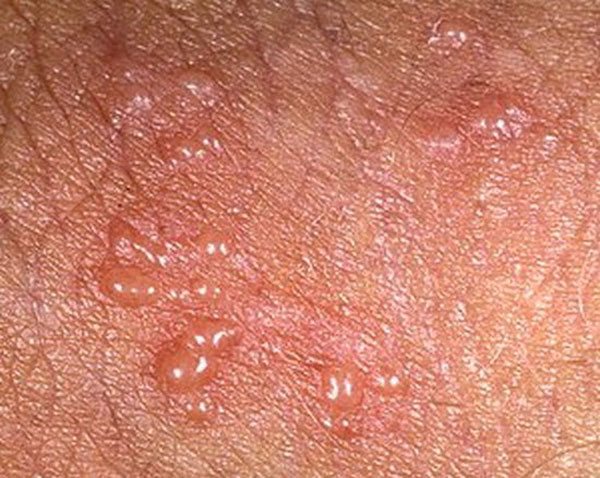
The following treatment regimen helps to get rid of erythrasma:
- make lotions from silver nitrate;
- treat the rash with iodine;
- use ointments Clotrimazole, Triderm, Mycoseptin;
- try ultraviolet irradiation in safe doses;
- if there is an infection, take a course of antibiotics.
For the treatment of psoriasis, modern medicine offers topical anti-inflammatory compounds, mud wraps and medications to enhance immunity.
Therapy
There is an opinion that herpes viruses, once they enter the human body, never leave it, and treatment is absolutely ineffective. This is wrong. Treatment of genital herpes in men can be very successful:
- At the first symptoms, it is necessary to start taking oral antiviral drugs (acyclovir, famciclovir). The course of treatment is 10 days;
- Drugs are inducers of interferon synthesis (arbidol, poludanum, flokazid). Duration of treatment is 10-14 days. In combination with general antiviral therapy, they effectively fight herpes;
- Anti-inflammatory drugs. Powders for hot drinks such as Coldrex and Theraflu contain antipyretics, vitamin C, and antihistamines. Used in the first days of the disease at high temperatures;
- Local treatment. Antiviral ointments (alpizarin, acyclovir, pencivir, Zovirax) are used locally throughout the course of the disease;
- To reduce itching, ointments containing antihistamines (fenistil, soventol) are used.
- It has been statistically proven that treatment of genital herpes in men, subject to an integrated approach to therapy, is effective in 70% of cases.
Fungus of the groin area in men
Treatment of inguinal athlete's foot involves taking measures to destroy the causative agent of the infection and eliminate the prerequisites for the development of the disease in the future.
Drug therapy
The following medications are used to destroy the fungus:
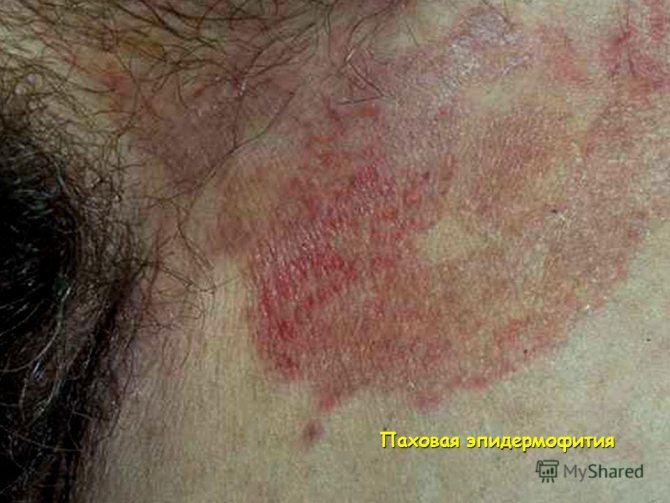
Antiseptics. The action of these drugs is aimed at destroying fungal mycelium at the cellular level. Salicylic acid has a good effect, which must be diluted with alcohol before use. Fukarcin and sulfur ointment can be used for the same purpose. Any of these drugs should be used to treat the affected surface 1-2 times a day.- Antimycotic and anti-inflammatory medications. Available in the form of ointments or creams, they are used as a topical agent. The drug is applied directly to the site of localization of the pathogenic fungus. Usually the doctor prescribes medications such as Lamisil, Miconazole or Pimafucin.
- Capsules or tablets that also have an antifungal effect are prescribed orally - Griseofulvin, Fucis, Ketoconazole.
- In addition, when treating fungus, it is mandatory to take immunomodulators and dietary supplements that help strengthen the immune system. Take a course of multivitamins, ginseng tincture, rosea radiola, echinacea extract and other products that have a similar effect.
- For severe itching, antihistamines are recommended - Supravtin, Zyrtec, Diazolin. The duration of treatment is determined by the degree of damage and the type of pathogenic microflora.
In the absence of complications, therapy lasts no more than a month. Do not allow the disease to become severe, as this can lead to serious complications.
ethnoscience
You can try to cure groin fungus in men using folk remedies, but the effectiveness of such drugs has not been proven and depends on a large number of factors. Many patients, trying to get rid of fungal infections, use folk remedies, but the disease progresses. Therefore, before using home remedies, you should definitely consult with your local dermatologist.
Itching in the groin area
There are the following folk recipes against itching in the groin area:
- Mix oak bark, flaxseed, yarrow and string in equal parts. Pour the mixture (1 tablespoon) with boiling water (1 l), cool. Moisten a piece of clean cloth with the medicinal composition and apply to the affected area.
- Take dry raw materials: yarrow, chamomile, St. John's wort, violet, eucalyptus and lingonberry in equal proportions. Brew 1 teaspoon of the composition with boiling water (200 ml), strain after 30 minutes. Take 100 ml orally three times a day.
- Fungus in the genital area can be removed using birch and poplar buds (in equal quantities) and a raw egg. Pour vodka over the ingredients. After a week, the composition is ready for use. It is used for lotions.
How to treat inflammation of the lymph nodes?
Accordingly, some diseases that are etiologically a complication of herpes may develop in the affected organ.
To relieve unpleasant symptoms, Foscarnet, Ganciclovir, and Cidofovir are prescribed. When treating a virus of any strain that has caused changes in the lymph nodes, a shock course of vitamin therapy is recommended. If severe Epstein-Barr virus infection or complications have developed, corticosteroids are recommended to relieve fever and inflammation.
To a large extent, herpes is associated with a feeling of disgust. Therefore, it can even become a reaction of disgust towards certain sexual partners, sexual intercourse with them, or to sexual intercourse in general. Therefore, patients suffering from herpes localized in the groin are always recommended to undergo a psychotherapeutic examination. Perhaps this is precisely the true reason for the constant activation of this infection in a particular organism.
Not taking the disease seriously, lacking the desire to cure the virus or seek medical help. Some men do not pay attention to redness and rashes on the penis and other symptoms, letting everything take its course, and this leads to complications and frequent exacerbations.
Herpes must be treated despite the fact that it is impossible to completely destroy it in the body. Correct and timely treatment will avoid the development of complications and reduce the severity and duration of herpes relapse.
The lymphatic system in the human body plays no less a role than the circulatory system. Its functions include cleansing tissues of metabolic products and fighting infections. Lymph nodes are special organs in which the destruction of foreign agents (for example, bacteria, tumor cells, etc.) occurs, and special cells of the immune system mature.
- Penciclovir;
- Pain (ache) in the joints.
It is believed that against the background of relapses of herpes, the risk of developing certain bacterial diseases may increase, and the appearance of immunodeficiency and malignant tumors is facilitated.
Before starting treatment, you must seek help from competent specialists. It is extremely difficult to independently determine the causes of itching in the groin in men from a photo. Doctors, after conducting a diagnosis, will be able to prescribe the necessary medications for you.
The liquid in the blisters begins to become cloudy on the 3-4th day, then the blisters burst, and the patient experiences weeping erosion. Sometimes erosion can turn into painful ulcers, which dry out and become crusty by 5-7 days. After the scabs fall off, a dark red spot remains in place of the blisters.
Diaper rash in the groin in women - treatment of diaper rash in the groin. How to treat diaper rash in the groin in women?
Itching in the groin area in men is a rather unpleasant symptom that can cause significant discomfort. Many men experience itching in the groin, but often do not pay much attention to it. Such neglect can lead to the development of a serious illness. The desire to itch in such an intimate part of the body arises for many reasons, and not all of them are harmless.
As a rule, itching in the groin in men is not the only symptom of a pathological condition. Depending on the etiology (cause), itching may be accompanied by the following symptoms:
- Hyperemia (redness of the skin). With constant scratching, the skin becomes pink and then bright red;
- Skin rashes. In some cases, pinpoint hemorrhages of a scarlet hue may be observed. They appear due to mechanical effects on the skin. But sometimes there is a rash characteristic of various infectious diseases;
- Burning in the groin area. This symptom is caused by a violation of the integrity of the upper layer of skin due to friction and scratching;
- Cracks in the skin. If the cause is not identified and eliminated for a long time, then cracks and ulcerations form on the skin;
- Irritability. The unpleasant sensations that a person constantly experiences affect his psychological state. The man becomes irritable and hot-tempered. As a result, performance decreases;
- Sleep is disturbed. It becomes intermittent or insomnia occurs;
- Discharge from the urethra of varying intensity. If you have this symptom, you should not delay visiting a specialist.
Associated symptoms often help determine the causes of itching in the groin in a man.
The etiology of itching is quite diverse. It includes both harmless causes and serious diseases of the reproductive system or other organs. Treatment tactics will depend on the etiology.
Irritation often occurs due to poor personal hygiene. In this case, the treatment is quite simple and consists of keeping the body and linen clean.
Sexual infections and diseases of internal organs require an integrated approach and sometimes long-term treatment. If an allergic reaction occurs, appropriate medications (antihistamines) are prescribed, and the allergen is identified and eliminated.
Itching in the groin area in men can be one of the signs of a fungal disease of the genital organs - thrush. When the body is weakened, exhausted, or there is a decrease in defenses, the fungus becomes active.
Symptoms that will help diagnose candidiasis:
- Itching;
- Burning;
- Characteristic discharge, it is white in color and has a cheesy consistency;
- The presence of plaque on the head of the penis, it can be white or gray;
- In advanced cases, a sour smell is felt;
- Swelling of the soft tissues of the penis and foreskin.
In this case, drug and non-drug treatment methods are used. Non-drug therapies include:
- Careful observance of personal hygiene rules, it is necessary to remove secretions;
- Diet therapy, which is aimed at restoring microflora. It is necessary to limit the consumption of confectionery and flour products. Preference should be given to fermented milk products, vegetables and unsweetened fruits;
- Chamomile decoction is used to make sitz and local baths. It has anti-inflammatory, soothing and healing properties.
Drug therapy consists of local and general treatment. Ointments and creams for thrush are used locally (for example, Clotrimazole, Pimafucin).
General therapy:
- Antifungal drugs in tablet form (Pimafucin, Fluconazole, Nystatin);
- Vitamin complex - prescribed to strengthen the immune system;
- To normalize the microflora of the intestines and genital tract, drugs such as Bifidumbacterin, Yogulact and others are prescribed.
Dermatomycosis
Dermatomycosis is damage to the skin by pathogenic fungi. The groin area of a man is a favorable environment for the development and activity of fungi. This is due to the fact that the skin folds of the groin area are moist and maintain a constant optimal temperature for the reproduction and growth of fungi.
Wearing tight underwear and clothing is a predisposing factor, since constant friction combined with an active lifestyle leads to microtrauma of the skin in the groin area. Wet underwear also contributes to the development of this disease; the fungus loves humidity.
Symptoms of dermatomycosis:
- Itching;
- Local hyperemia (skin acquires a pink tint, redness in the form of spots);
- The presence of blistering rashes in the groin area, on the thighs and scrotum.
It should be remembered that the bubbles do not extend to the penis
Treatment of itching in the groin in men, in the case of dermatomycosis, includes:
- The use of antifungal drugs (Termikon, Terbinafine);
- Lotions with antiseptic solutions (Chlorhexidine, Furacilin);
- Antihistamines – relieve itching and irritation (Suprastin).
Herpes
Genital herpes is transmitted sexually. People with severe symptoms of the pathology are most contagious, but transmission of the infection is also possible from an asymptomatic carrier. Genital herpes occurs in people with reduced immunity.
Herpes has clear symptoms:
- Severe itching and burning in the groin area in a man;
- Swelling of soft tissues;
- Possible general malaise (headache, nausea, fever);
- Blistering rashes, elements of the rash are filled with clear liquid;
- After the blisters burst, painful ulcers form;
- Painful urination (in the presence of ulcerative lesions of the penis).
Treatment consists of taking general antiviral drugs (Acyclovir, Famciclovir). Local forms are not effective in this case. Immunostimulants and vitamin complexes are also prescribed, which help strengthen the body's defenses.
Men often itch in the groin due to poor hygiene. Sweat and sebum, especially in the warm season, are produced in large quantities. If natural skin secretions are not washed off regularly, irritation and itching may occur.
In this case, the man is recommended:
- Carry out water procedures twice a day, paying special attention to the intimate area;
- You can wash yourself using decoctions of medicinal herbs (chamomile, oak bark, sage);
- Wear underwear made from natural fabrics (cotton), avoid synthetic underwear at least for a while;
- You can apply regular baby powder to the skin in the groin area;
- It is recommended to refrain from intimacy, visiting the bathhouse, swimming pool and sauna.
If the itching does not go away within 5 days, you should consult a doctor.
Allergies can also cause itching and irritation in the groin. In this case, the man is concerned about the following symptoms:
- Irritation;
- Small pinpoint rashes or large red spots;
- Swelling.
An allergic reaction in the form of dermatitis or urticaria can occur to various foods, medicines (local and general), hygiene products (soap, shower gel), as well as to synthetic materials from which underwear is made.
For successful treatment it is necessary to identify the allergen. It is recommended to carry out careful hygiene of the genitals to avoid infection. Antiallergic (antihistamine) drugs are prescribed: Suprastin, Diazolin.
Chlamydia
Chlamydia is a sexually transmitted disease caused by chlamydia. For a long time, this disease can be asymptomatic and detected only during a preventive examination. However, many men may be bothered by characteristic signs of infection:
- Itching;
- Irritation of the glans penis;
- Pain during sexual intercourse and urination;
- Transparent discharge from the urethra, their amount is insignificant.
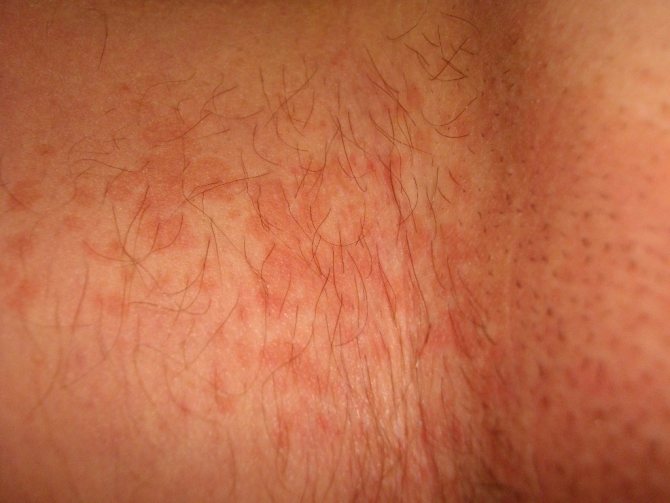
Treatment is based on the use of antibacterial drugs (Clarithromycin, Azithromycin). To increase the body's defenses, it is necessary to take immunomodulators (Lysozyme, Dekaris).
During treatment, you should avoid drinking alcohol and having sex.
Scabies
The scabies mite is the causative agent of scabies and the cause of itching in the intimate area in men. Itching and irritation bother people more at night, when mites make passages in the upper layer of the epidermis (skin).
Symptoms first appear on the hands (in the interdigital space), and then in the groin
Characteristic signs of the disease are:
- Itching and scratching with the formation of crusts;
- Rashes;
- The passages of the scabies mite.
When the first signs of pathology appear, you should consult a specialist. Self-medication is unacceptable, as the situation can only get worse. As a rule, antiparasitic ointments are prescribed.
Ureaplasmosis
Ureaplasma, which is the causative agent of this infection, causes inflammation in the genitourinary system. In men, this infection manifests itself with vivid symptoms:
- Pain when urinating, which is a symptom of urethritis (inflammation of the urethra);
- Scanty discharge from the urethra is usually transparent;
- A burning sensation that is localized in the penis itself.
If treatment is not carried out, there is a high probability of developing infertility. Treatment is aimed at destroying ureaplasma. For this purpose, antibiotics are prescribed: Ornidazole, Doxycycline. The drug Wobenzym will help support immunity.
Diabetes
A man may itch in the groin area due to increased blood sugar (diabetes mellitus). This disease can be suspected when a man makes the following complaints:
- Drinking large amounts of water (constant thirst);
- Discharge of urine frequently and in large quantities;
- General weakness;
- Constantly want to sleep;
- Itching in the groin folds, between the buttocks, in the popliteal and elbow areas.
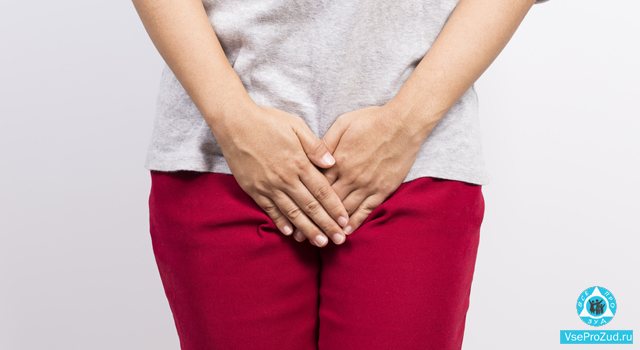
If these signs are detected, a blood sugar test is prescribed. Treatment should only be prescribed by a doctor.
The causes of itching in a man can be not only infectious diseases, fungi and allergies, but also pathology of internal organs. Itching is a secondary symptom of such diseases:
- Kidney pathology. In this case, the level of nitrogen in the blood increases, which is why sweat greatly irritates the skin. The groin area is equipped with a large number of sweat glands, which is why sweat is released in large quantities and irritation of sensitive skin occurs;
- Pathology of the liver and pancreas (cholelithiasis). Jaundice is accompanied by severe itching, including in the groin area;
- Hormonal imbalance due to thyroid pathology;
- Mechanical damage to the skin in the groin due to friction;
- HIV. The human immune system is weakened, and in the terminal stage (AIDS) it is completely destroyed. This condition may be accompanied by redness, itching, rash and ulceration of the skin in the groin in men;
- Weakening of the immune system after illness;
- Skin itching is observed with helminthic infestation.

